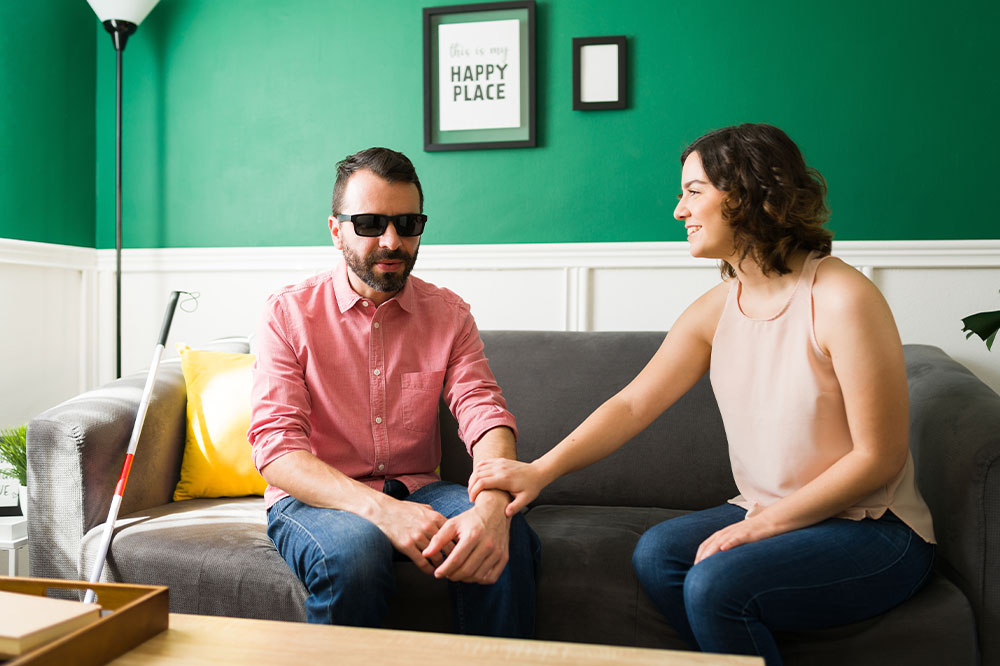Millions of people in our country suffer from eye disorders, one of the most prevalent being age-related macular degeneration. The condition affects a part of the retina called the macula, resulting in loss of central vision. Besides using treatments, those with macular degeneration or any other eye disorder must modify their homes to make them safer and minimize the risk of accidents. Redesigning the living space allows you to be comfortable and independent.
Change the bulbs
Macular degeneration makes it hard to read in dim lighting conditions. But while bright lighting is beneficial, you cannot stuff your home with high-voltage lamps, as they cast shadows and may confuse you. So, experiment with cool fluorescent or warm incandescent bulbs. They have a cooler and softer light that helps you navigate your way better. And ensure the lamps are focused on objects away from people’s faces.
Re-arrange the furniture
A cluttered house with furniture may increase the risk of falls and injuries. To prevent this problem, choose furniture with textured surfaces. It will help you know where you are in the house. Secondly, placing brightly-colored vases near bigger pieces of furniture will help you locate furniture easily.
Maximize natural light in the house
There is nothing like soft natural light or sunshine. It improves the home’s aesthetics, makes the transition between different spaces easier, and reduces eye strain due to harmful artificial lights. To ensure sufficient natural light penetration, avoid using heavy and dark-colored curtains, keep your windows clean, and add more mirrors that reflect light.
Label household items
Labeling items goes a long way in keeping the space organized. You not just find things easily but also minimize tripping hazards. Start with labeling cupboards, light switches, and drawers. Ensure the labels are correctly printed with large font sizes for readability.
Color code daily-use items
Another way to quickly find things while living with macular degeneration is to color-code items around the house. It helps locate them without feeling frustrated and also prevents accidents. To ensure the color codes are effective, use large-sized pieces of paper and bright colors. While color coding essential items can take a few days, it is an idea worth considering for the long term.
Use contrasting tape
When diagnosed with macular degeneration, you may find it challenging to differentiate between similar-looking colors. Older people, in particular, may even find uneven surfaces blending, increasing the risk of injuries. A simple tip to avoid this is to place brightly-colored tape on spots like doorframes, edges of the counters, and around light switches. Contrasting tape is easily available at online and offline stores and does not cost much.
Make the stairways safer
The stairs can be risky for people with low vision. To make them safe to traverse, paint the banisters and handrails a different color, color code every step differently, and, if needed, add extra lighting to the stair area. Follow this for every flight of stairs in the house and even at the main door.
Redesign the bathroom area
The bathroom can be a scary place when living with macular degeneration. Having a fall is the last thing you want to deal with. To make the place friendlier to navigate, replace slippery tile floors with sturdier and better-textured rubber tiles and add brightly-colored mats to create layers on the surface for better visibility.
Make the kitchen safer
Navigating the kitchen area may be complex for macular degeneration patients, thanks to sharp objects, stove tops, and water spills. Paint the cupboards bright to make locating food items easy, keep a magnifying glass handy to read food labels, and purchase knives and cutting boards with sheaths to avoid cutting your hand.
Make the flooring safe
Slippery floors, especially those done in tiles, may result in a nasty fall or serious injury. Fortunately, it is easy to make your flooring safe. All you need to do is invest in a low-pile industrial carpet to reduce friction. You can also place a no-skid overcoat on the floor. Do not forget to tape the edges of the carpets and overcoats to the floor for better protection.
Free up the walking spaces
Unknowingly, our home spaces get cluttered with many knick-knacks, which may be bothersome for people with vision problems. So, relook at your floor space and remove low-lying objects like coffee tables or floor-seating arrangements. Also, keep the chairs pushed in, ensuring they do not obstruct the way. The best way to achieve a de-cluttered space is to discard unwanted items as soon as they begin to pile up and crowd the home.
Use talking devices
Smart devices with talking features can help make the home comfortable and safe. Some come with voice commands to help turn on the lights, lock and unlock doors, and contact family and friends in an emergency. These functions are all the more beneficial for seniors with eye disorders and those living alone. However, some talking devices can be expensive, so compare the prices by multiple vendors and choose the best deal.
Do not forget the outdoors
Keeping your outdoors safe is as important as your indoor spaces. The garden spaces and pathways must be well-lit. Installing alert devices with motion sensors will keep the space safe while keeping your electricity bills low.
Those with macular degeneration may need to see the finer details in close or far-away objects. So, optimizing the home space is essential. Think creatively and focus on making the areas accessible and safe. While these adjustments and modifications can take time and effort, they are worth investing in. But do not forget to consult a healthcare provider for the proper diagnosis and treatment. Doctor-recommend treatments are essential to keep the symptoms in check and prevent the condition from worsening.



